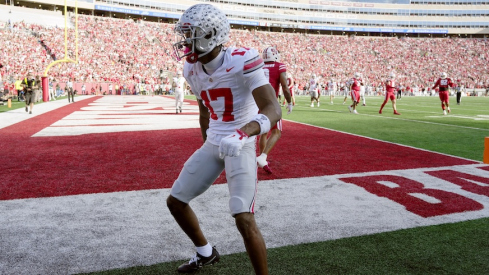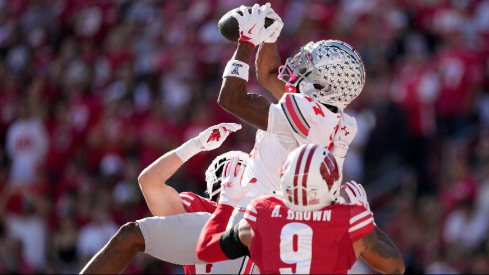
With key starters returning, the Ohio State defensive performance against San Diego State exhibited the Buckeye defense's potential. The 2013 Buckeyes' defense has the potential to outperform its 2012 counterpart because of its experience in the secondary and athleticism up front.
The Ohio State coaching staff was able to employ more aggressive, diversified looks with Bradley Roby's back at boundary corner. The result was nearly preventing San Diego State from gaining a first down in the first quarter and eventually limiting the Aztecs to one touchdown.
Below I examine the defensive schemes employed by the Buckeyes, the potentially dominant defenders in the Buckeyes' front four, and the Buckeyes' possible response to California's Air Raid offense under Sonny Dykes and Tony Franklin.
Playing with a Full Hand
As expected, Roby and CJ Barnett's return permitted the defensive coaching staff to implement more of its playbook. This was in part permitted by the San Diego State offense. The Aztecs employ a pro-style offense, mixing between 21 personnel (2 WR, 1 TE, 1 HB, 1 TB) and 3+ wide receiver sets. The former permitted the Buckeyes to deploy their base 4-3 look with Sam linebacker Josh Perry. In the base defense, the Buckeye coaching staff primarily called for a 4-3 under, but the Buckeyes also played a 4-3 over, with the 3 and viper going to the formation strength, and the nose guard and 5 technique to the boundary.
As can be witnessed above, the Buckeyes used a fair amount of inside linebacker blitzes, both off the initial snap and delayed blitzes once a running back stayed in pass protection.

In the secondary the Buckeyes often deployed single high safety coverage, whether it be cover 1 or cover 3 (see above). Consistent with the Buckeye defensive coaching staff's overall approach, this was particularly true against pro personnel groupings. With Roby's return the Buckeyes were also able to utilize a quarter-quarter-half scheme.
Demonstrating their commitment to rely more upon their secondary, the Buckeyes also unveiled a check to man-over coverage against San Diego State's twins formation (two receivers to one side). That meant that the corner from the side away from twins – here boundary corner Roby – would come across to play the slot receiver.

Slidin' Down
In passing downs the Buckeye defense continued to refine their dime scheme. Ohio State's basic approach is to run their 4-2-5 nickel defense but have the defensive line slide down. Three technique Michael Bennett moves to nose guard. Five technique Adolphus Washington or Joey Bosa moves inside to 3 technique. Backup viper Steve Miller came in at 5 technique, with Noah Spence remaining at his viper spot.
Ohio State takes the same approach at linebacker. Ryan Shazier moves to mike linebacker with backup safety Corey Brown entering as the will.
The Buckeyes' hope in doing so is generating a pass rush with their front four while playing tight zone coverage. Ohio State often played base cover 2 or cover 3 from dime, perhaps blitzing Shazier if a running back remained in pass protection. The package was effective because the Buckeyes were able to consistently generate a pass rush with their down linemen.

Settin' the table
The Buckeyes' defense has the potential to surpass last year's squad because of the high ceiling of certain members. It begins in the secondary, where the talent and experience permits the Buckeye coaching staff more leeway. Players like Roby and Shazier are a given. But the most promising aspect is the emergence of new starters along the defensive line. Noah Spence has been as good as advertised, controlling the edge against the run as well as rushing the passer.
The quickly emerging linchpin of the Buckeye defense, however, is Michael Bennett. Urban Meyer has sung Bennett's praises for his work ethic in practice, and it is translating to the field. Bennett is thriving at the critical 3 technique. He is proving an adept pass rusher from the interior, using his quick first step to beat offensive linemen. Perhaps more importantly he is holding up against the run despite being slightly undersized for the position.
The other pleasant surprise has been the emergence of depth in the form of Miller and freshman defensive linemen Bosa and Michael Hill. Their play has been critical to a defensive line rendered thin by injuries to Tommy Schutt and Adolphus Washington. Miller has emerged as a pass threat from the Buckeyes' dim look, providing the Buckeyes two speed edge rushers.
We're Just Air Raidin' It
The Buckeyes' defense will receive an entirely different test in Sonny Dykes and Tony Franklin's Cal Bear Raid offense. The term is apparently Dykes and Franklin's play on words for their variation of the Air Raid they have honed at Louisiana Tech. I previewed Cal's new offense this summer. For those looking for serious in-depth reading, Brophy's Blog Spot provides an extensive analysis of Dykes and Franklin's schemes.
In brief, Dykes and Franklin have taken Hal Mumme and Mike Leach's Air Raid and pared it down to go fast. Louisiana Tech's offense regularly ran more plays then any team in the nation; a pace they are seeking to emulate at Cal. To do so Dykes and Franklin had eliminated much of the Air Raid's down field pass offense in favor of stretching the defense horizontally with packaged plays.
A packaged play is where the offense provides the quarterback a run/pass option after the snap. Below, Cal packages inverted veer with a quick out route. The quarterback reads the front side corner. If he fails to respect the out route the quarterback quickly pulls the ball and delivers the throw. This puts defenders in a bind. If they play the pass it creates lanes for the run play, but if they abandon the receiver it provides an easy pass opportunity.

Franklin and Dykes combine the horizontal stretch of inside zone and power with quick passes and wide receiver screens with the occasional shot down field. The duo keep defenses off balance by quickly transitioning from spread sets to the diamond formation to run power.
Unlike San Diego State, Ohio State will nearly always be in at least nickel coverage. Expect the Buckeyes to play extensive amount of their dime scheme when Cal goes four and five wide. The Buckeyes will likely employ varieties of cover 4 pattern match coverage to deal with Cal's packaged plays. A defense cannot play traditional man against packaged plays because the offense will gain easy rushing yards while defenders are turned in coverage.
Cal will thus provide an interesting challenge for the Buckeyes' defensive squad. But Ohio State is in as good a position as any to deal with the scheme given their secondary experience. And the Buckeyes' best defense may be their offense against the Bears' overmatched defense.

